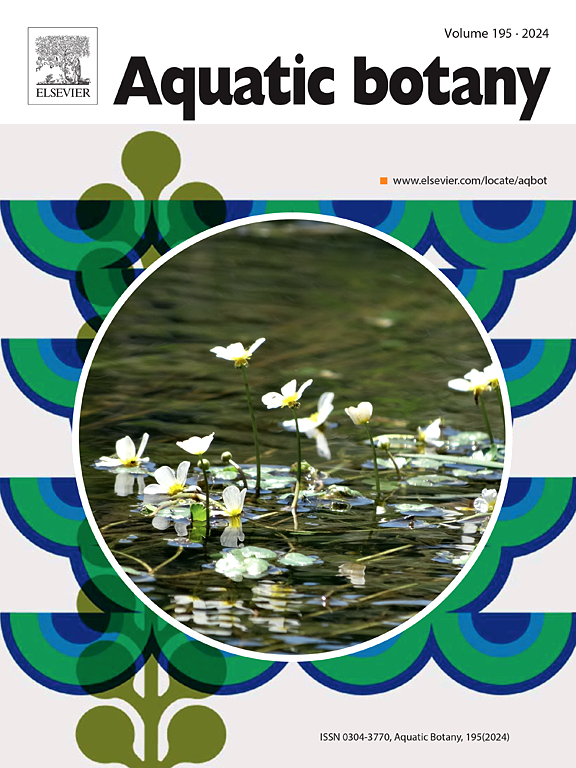具有重要经济价值的真卤植物 Salicornia brachiata Roxb.
IF 2.6
4区 生物学
Q2 MARINE & FRESHWATER BIOLOGY
引用次数: 0
摘要
盐生草本植物属(Salicornia)的成员在高盐度条件下生长旺盛,是盐碱地农业的潜在候选植物,因此在全球范围内颇具吸引力。然而,几十年来,由于其成员对极端环境条件表现出可塑性反应,以及形态学和分子鉴定方法之间的不一致,该属在分类学上一直是一个具有挑战性的属。虽然只有少数商业种植的莎草物种得到了完整的描述,但包括 S. brachiata(印度次大陆、缅甸和斯里兰卡的原生物种)在内的大多数物种都没有得到很好的描述。鉴于盐肤木在盐碱地农业中的适应潜力,本研究旨在建立一个基于形态学和 DNA 条形码的物种划分系统,并为未来的作物改良项目研究授粉生物学。从斯里兰卡的两个种群中采集了初步鉴定的 S. brachiata 植物样本,并对其进行了完整描述。除了一个叶绿体基因组外,GenBank 中缺乏关于 S. brachiata 的经过验证的条形码数据。本研究首次获得了 S. brachiata 的 ITS、ETS 和 matK 三个条形码区域的明确序列,可用于准确的物种鉴定。研究了花序不同部位的繁殖动态。在该属植物中首次记录到了异花授粉交配系统,虽然花序中的下部小花显示出对外交的偏好,但上部小花显示出对自交的适应。这些数据可有效地用于未来的莎草育种计划。本文章由计算机程序翻译,如有差异,请以英文原文为准。
Species identification and pollination biology of an economically important true halophyte, Salicornia brachiata Roxb.
Members of the genus Salicornia have gained a global attraction due to their ability to thrive under high saline conditions and as potential candidates in saline agriculture. However, it has been a taxonomically challenging genus for decades since the members show plastic responses to extreme environmental conditions and due to incongruences between morphological and molecular identification methods. While only a handful of commercially grown Salicornia species are fully described, most of the species including S. brachiata, a native species in the Indian sub-continent, Myanmar, and Sri Lanka are poorly described. With the potentials in adapting S. brachiata in saline agriculture, the aim of this study was to establish a morphology and DNA barcode-based species delineation system and to study pollination biology for future crop improvement projects. Tentatively identified S. brachiata plant samples were collected from two populations in Sri Lanka and completely described. GenBank lacked authenticated barcode data for S. brachiata except for one chloroplast genome to which the matK sequence obtained in the present study matched with 100 % identity. For the first time, well defined sequences of three barcode regions, ITS, ETS and matK, of S. brachiata were made available for accurate species identification. Reproductive dynamics in different parts of the inflorescence was studied. A facultative xenogamous mating system was recorded for the first time in the genus and while the lower florets in the cladode showed a preference towards outcrossing, the upper florets displayed adaptations for selfing. Data could be effectively utilized in future Salicornia breeding programs.
求助全文
通过发布文献求助,成功后即可免费获取论文全文。
去求助
来源期刊

Aquatic Botany
生物-海洋与淡水生物学
CiteScore
3.80
自引率
5.60%
发文量
70
审稿时长
6 months
期刊介绍:
Aquatic Botany offers a platform for papers relevant to a broad international readership on fundamental and applied aspects of marine and freshwater macroscopic plants in a context of ecology or environmental biology. This includes molecular, biochemical and physiological aspects of macroscopic aquatic plants as well as the classification, structure, function, dynamics and ecological interactions in plant-dominated aquatic communities and ecosystems. It is an outlet for papers dealing with research on the consequences of disturbance and stressors (e.g. environmental fluctuations and climate change, pollution, grazing and pathogens), use and management of aquatic plants (plant production and decomposition, commercial harvest, plant control) and the conservation of aquatic plant communities (breeding, transplantation and restoration). Specialized publications on certain rare taxa or papers on aquatic macroscopic plants from under-represented regions in the world can also find their place, subject to editor evaluation. Studies on fungi or microalgae will remain outside the scope of Aquatic Botany.
 求助内容:
求助内容: 应助结果提醒方式:
应助结果提醒方式:


